Introduction
This webpage is a summary of Parts 1 to 3 of the Spacetime Model.
Internet users who have already read these parts of the Spacetime Model can bypass this page and move directly to the next webpage Electromagnetism.
ElectromagnetismPart 4
Spacetime Model |
IntroductionThis webpage is a summary of Parts 1 to 3 of the Spacetime Model. Internet users who have already read these parts of the Spacetime Model can bypass this page and move directly to the next webpage Electromagnetism. What is Mass?The mass and gravitation enigmas lie in the concept of VOLUME. All objects in the universe can be classified in five different types of volumes described in Part 1. The three main classes of volumes are:
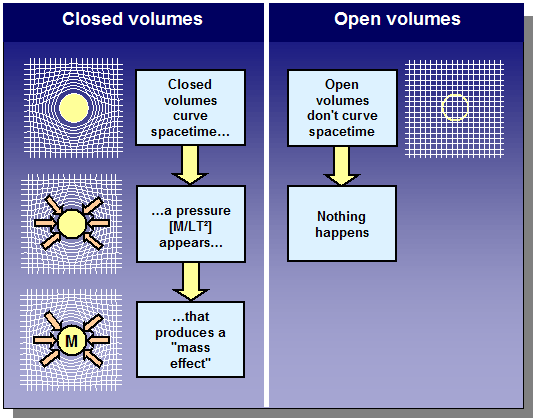
Mechanism of Mass and GravitationPart 1 of the Spacetime Model demonstrates that mass and gravitation are nothing but the consequence of the pressure of spacetime on closed volumes ("closed volumes", not "apparent volumes"). As figures (a) and (b) show, we are faced with the same phenomenon. Gravitation is not an attractive force between masses, but a pressure force exerted by spacetime on closed volumes that tends to bring them closer to each other. The result is identical to that of an attraction. For example, a pressure on one side of a sheet of paper is equivalent to an attraction on the other side. In both cases, the sheet is curved. 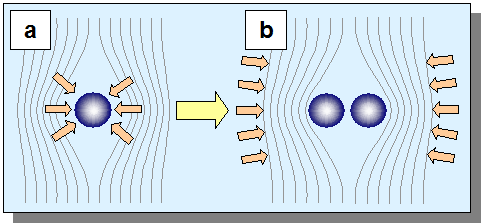
Wave-Particle DualityMatter presents the particularity of having a wave and particle behavior.
This phenomenon is known as the wave-particle duality.
However, wave-particle duality also exists on Earth, as shown by the following figure.
To get a wave-particle duality on Earth, the only criterion required is that the wave, particle and medium
must have the same constitution.
Wave-Particle Duality LawsLaw #1
. . . have the same constitution. Law #2 Law #3
Speed of lightThis section shortly explains why the speed of light is constant, at 299,792,458 m/s. The problem of velocity additions suggests that we are in the presence of two distinct media:
This leads to think that the Apparent Medium and the Real Medium are overlaid. Part 2 of the Spacetime Model explains that this "real medium" is noting but the global spacetime of the universe. 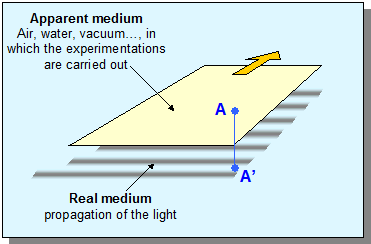 Constant Speed of LightLet's imagine the emission of a beam from a laser diode "A", fixed on a motionless Apparent Medium. Contrary to what we think, the beam emitted from A does not reach the point L directly but via the real medium: A → A' → L' → L. 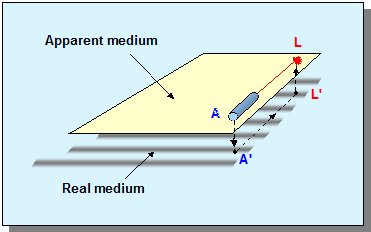 Now let's consider that the apparent medium is moving with the velocity "V" (figure below). An external observer, such as Fizeau in the 1900s, could think that the total speed will be the sum of the speed of the light, V(A-L), plus that of the apparent medium, V(L-X). 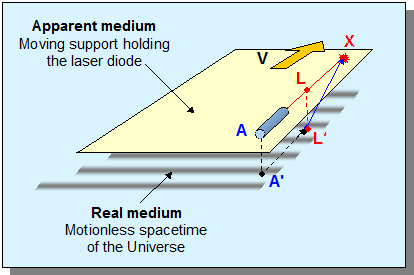 In reality, the speed of light will be constant, whatever the speed of the apparent medium, because the light is not propagated in the apparent medium but in the real medium, i.e. the global spacetime of the universe. Case of two Reference SpacesThe figure below shows a photon which is emitted from an apparent medium A to another apparent medium B. The two apparent media are moving in the opposite direction. In this case, no one can explain why the speed of this photon is constant. 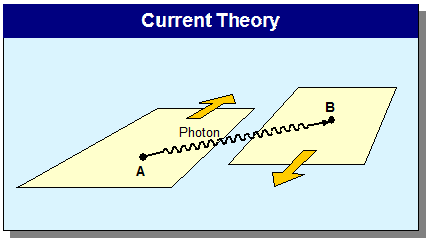 This website explains in the next pages that
In other words, the photon does not exist per se. It is nothing but a mathematical concept. In reality, the light is not propagated directly from A to B, but through the real medium from A' to B' (or conversely), i.e. in the global spacetime of the universe. As a result, the speed of light is exclusively a function of spacetime characteristics, i.e. spacetime permittivity ε0, and spacetime permeability μ0. Thus, the speed of light is always 300,000 km/s, whatever the relative velocity of the two apparent media from where the light is emitted. 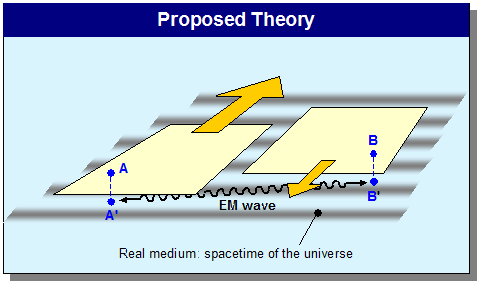 Spacetime Cells, or "sCells"It would seem that the global spacetime of the universe is divided into quanta called "Space-timeCells" or "sCells", which are nothing but neutral electrons. Therefore, sCells could have a closed volume equivalent to 511 KeV but, like neutrinos, they cannot be detected. In particular, sCells explain with logic and good sense the constitution of quarks, show where is located the antimatter in the Universe, and solve several enigmas of modern physics. Moreover, they are the only solution to explain two basic forces, gravitational and electromagnetic forces.
So, we will use sCells repeatedly in this website, particularily to explain electromagnetism, Young slits, and the Heisenberg Relation. The Wave ModelThe explanation of wave-particle duality leads to an important deduction: electrons are not moving around
the nucleus as a punctual particle but as a stationary wave, which is a sort of "cloud of charge".
Indeed, the charge of the electron is distributed into the sCells surrounding the nucleus.
The formulas of quantum mechanics as Schrödinger Equation are not modified by this new approach.
It is only an explanation of the phenomenon.
|